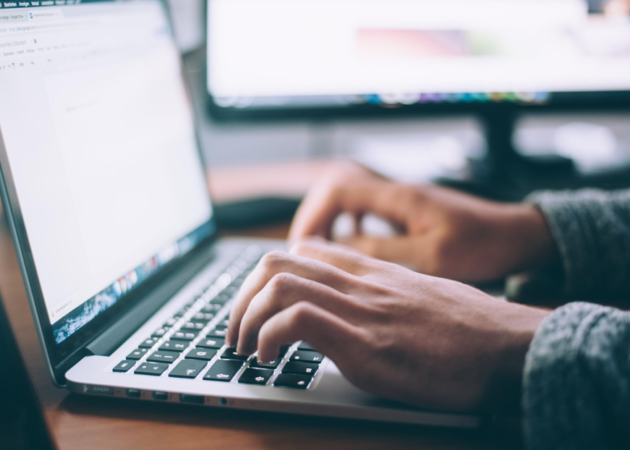
Digital fatigue is said to be a state of mental exhaustion and disengagement. This occurs among people who are required to use different digital devices simultaneously or use them for multiple uninterrupted hours per day. This condition is relevant to many employees today as they work from home due to the pandemic.
Breaking away from devices can be more difficult while quarantining due to limited social and entertainment options. Between smartphones, computers, televisions, tablets, etc., you are likely using them for the majority of the day. In fact, a 2019 study stated that the average American picked up their phone 96 times per day, which undoubtedly increased in 2020.
It’s no wonder why we may be suffering from digital fatigue! If you’re experiencing related symptoms, it may be time for a digital detox. Fortunately, there are many work-from-home strategies that can help you limit screen time. It may be difficult initially because it has become an addictive habit to many and is unavoidable during business hours, but you can beat this condition with a few simple tips.
Use Your Resources
There are many resources you can use to limit the blue light exposure from digital screens. These resources can help you when engaging with a screen is unavoidable.
Digital screens produce digital blue light, which is a color on the visible spectrum. Each color of light on the this spectrum produces varying concentrations of energy and wavelengths. Digital blue light has a high concentration of energy and short wavelengths, which makes it more stimulating to the eyes than its counterparts.
Night Shift
Night Shift is an Apple display setting that you can adjust to limit the amount of blue light that is emitted through your iPhone, iPad, or MacBook screen. The “warmer” the color setting, the less blue light it emits, while the “cooler” the color setting, the more it emits. You can set Night Shift to adjust automatically, or you can adjust it manually based on your personal needs.
Blue Light Glasses
A more recent development in the attempt to limit digital fatigue is using blue light blocking glasses. These glasses have a specific lens that helps filter out the blue light that is emitted from screens.
By wearing a pair of blue light glasses you will be proactively reducing eye strain, enhancing focus, and ultimately increasing productivity throughout your workday. It’s suggested that you wear these glasses when engaging with any digital device for a long period of time, and especially before bed. This is because blue light can also negatively affect sleep patterns as it’s a high-energy stimulant that increases alertness and decreases the natural development of melatonin, which helps you fall asleep.
Natural Light
There is a difference between natural blue light, which is produced through sunlight, and digital blue light. Natural blue light regulates the body’s sleep-wake cycle and provides increased alertness and cognitive function during the day.
Although digital blue light is similar to natural blue light, digital screens are used in closer range, very frequently, and after sundown, which can adversely confuse the senses and damage eyesight.
When you’re using your digital devices, be sure you’re in a well-lit room, preferably with natural lighting. Doing so keeps you from straining your eyes and confusing your senses. When you’re using electronics after sundown, make sure the room is still well lit and use your other resources, like Night Shift and your blue light glasses, to limit your exposure.
Ergonomic Furniture
Fiinally, employers should consider supplying employees with ergonomic office products and furniture to help them beat the effects of digital fatigue and employee burnout. Ergonomic office supplies, like a monitor arm or an adjustable desk riser, can help employees maintain healthy posture and proper distancing from their screens. Ergonomic desk chairs can also benefit remote employees as they align the shoulders, hips, and spine, in order to reduce abnormal strain on the back and prevent harmful positions such as slouching and forward-leaning that push employees closer to their screens.
Avoid Multitasking
It’s common to think that you can use a short opportunity to complete more tasks in less time, but research has proven that multi-tasking actually cuts into successful performance.
Focus on One Task at a Time
Many employees tend to bounce around from tab to tab trying to accomplish more at once, and that can lead to further fatigue. Studies have found that switching between tasks can cost you as much as 40 percent of your productivity and decrease your memory function. If possible, focus on one task at a time and complete it efficiently before moving on to the next.
Focus on One Device at a Time
Similarly, employees are also commonly known to switch from device-to-device when trying to complete a task. Most employees use multiple screens and check their smartphones or tablets throughout the day during working hours. This habit can cause severe over-stimulation and burnout very quickly. It’s healthier to use one device at a time, if possible, and take breaks in between.
Break Up Your Day
Right now, many employees are working from home to abide by social distancing rules. Unfortunately, working remotely can be quite draining as you’re living and working in the same space and from a more isolated environment that you may not be used to or as comfortable in as the office.
Take a Digital Break During Lunch
During this time, lunch breaks are different. If you’re working from home, you’re likely watching TV or using your smartphone during your breaks as a source of entertainment, instead of going out for lunch or conversing with co-workers.
Instead, consider your lunch break a good time for a mid-day digital detox. If you give your eyes and mind a strict 30-minute reprieve from screens during your lunch break, it will give you time to reset before the second half of your day, which can help with productivity. Try going for a walk or closing your eyes for a quick meditation session to refocus.
The Pomodoro Technique
The Pomodoro Technique is a time management method that helps people focus and take frequent breaks. To properly use this method, you will:
- Break your workday into 25-minute increments, separated by 5-minute breaks.
- Once you have worked for 25-minutes, you will take a 5-minute break.
- After a few rounds of the technique, you should take one longer break of about 15-minutes.
- To make the process as seamless as possible, use a custom study timer to schedule your 25-minute increments and short or long breaks.
The purpose of this exercise is to create a sense of urgency in your workday that will encourage you to complete your tasks more quickly and take breaks more often. During these breaks, you should rest your eyes and avoid looking at other devices that could cause digital fatigue. This is a great strategy for working from home because it’s easier to lose focus in a comfortable setting or forget to leave your computer as often as you should, due to meetings and fear of being inactive online.
Digital devices are all around us and there is absolutely no escaping them during this time. You can, however, use these simple work-from-home strategies to avoid their negative effects and purely focus on the positive ones. Now more than ever, with limited social calendars and remote work, you are at risk of overexposure and the crippling effects of digital fatigue that soon follows. Don’t let it slow you down—work with your technology, not against it.



